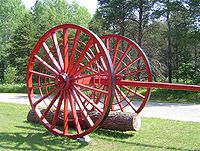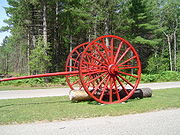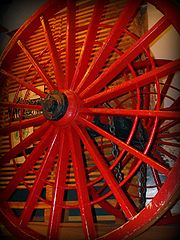
Michigan logging wheels
Encyclopedia




Skidder
A skidder is any type of heavy vehicle used in a logging operation for pulling cut trees out of a forest in a process called "skidding", in which the logs are transported from the cutting site to a landing. Here they are loaded onto trucks , and sent to the mill...
. It extended the season in which the logging industry could extract timber from the North Woods
North Woods
The Laurentian Mixed Forest Province, also known as the North Woods, is a forested ecoregion in Canada and the United States. In Canada it is found in Ontario around the Great Lakes and the Saint Lawrence River through Quebec to Quebec City...
of Michigan
Michigan
Michigan is a U.S. state located in the Great Lakes Region of the United States of America. The name Michigan is the French form of the Ojibwa word mishigamaa, meaning "large water" or "large lake"....
, by removing the need for icy ground to travel over. The logging wheels were a specially designed large set of wooden wagon wheels that could carry logs that were up to 100 feet in length, several at a time.
Michigan logging wheels (big wheels) were invented by Silas C. Overpack
Silas C. Overpack
Silas C. Overpack was a blacksmith, wheelwright, and businessman. He owned a shop in downtown Manistee, Michigan called S.C. Overpack Wagon, Carriage and Blacksmith Shop and is associated with the invention of Michigan logging wheels. These unusually large wagon wheels were used in the timber...
in 1875. At the time Michigan was the nation's leading producer of lumber. His equipment could be identified as genuine as it was always painted red.
Usage
Overpack's logging wheels could haul logs without the need for icy ground. They did not sink into mud in the wet terrain of the northern woodsWoodland
Ecologically, a woodland is a low-density forest forming open habitats with plenty of sunlight and limited shade. Woodlands may support an understory of shrubs and herbaceous plants including grasses. Woodland may form a transition to shrubland under drier conditions or during early stages of...
where ordinary wagon wheels would get mired in the spring thaw. The wheels also enabled a team of horses to pull several logs at a time. The logs were held by a chain that suspended the logs' weight from the wheel axle, creating a stabilizing, low center of gravity
Center of gravity
In physics, a center of gravity of a material body is a point that may be used for a summary description of gravitational interactions. In a uniform gravitational field, the center of mass serves as the center of gravity...
.
Sizes
Overpack sold three sizes of big wheels: 9 feet (2.74 m) high, 9 in 6 in (2.9 m) high and 10 feet (3.05 m) high; they cost $100 per diameter foot, a quite considerable investment for the time. Unlike a wagon which carries a load above its axle, these huge wheels carried logs chained beneath the axle. The wheels could carry logs from 12 feet (3.66 m) to 100 feet (30.5 m) in length and enough logs to total 1,000 to 2,000 board feet of lumber in a single load. The axles were manufactured from hard mapleMaple
Acer is a genus of trees or shrubs commonly known as maple.Maples are variously classified in a family of their own, the Aceraceae, or together with the Hippocastanaceae included in the family Sapindaceae. Modern classifications, including the Angiosperm Phylogeny Group system, favour inclusion in...
, and the 16-foot tongues were made of ironwood
Ironwood
Ironwood is a common name for a large number of woods that have a reputation for hardness. Usage of the name may include the tree that yields this wood...
. The wheels were clad with iron rims to protect them from stumps, fallen trees, and rocky terrain. Interior iron rings reinforced the wooden spokes of the wheels. They were pulled by horses, oxen, or tractors.
History
Overpack was a wheelwrightWheelwright
A wheelwright is a person who builds or repairs wheels. The word is the combination of "wheel" and the archaic word "wright", which comes from the Old English word "wryhta", meaning a worker or maker...
in Manistee, Michigan
Manistee, Michigan
Manistee is a city in the U.S. state of Michigan. As of the 2000 census, the city population was 6,586. It is the county seat of Manistee County. The name "Manistee" is from an Ojibwe word first applied to the principal river of the county. The derivation is not certain, but it may be from...
around 1875, when he was approached by a farmer to build a set of 8 feet (2.44 m) wagon wheels. He built these unusually large wagon wheels and sold them to the local farmer. Time passed and later this same farmer returned asking Overpack for an even larger set of wagon wheels. Overpack was very curious by this time. He asked the farmer what he was doing with such large wagon wheels. The farmer replied he was using them to skid logs.
From then on Overpack's big wheels were part of Michigan logging history. Many northern states used them, and Michigan alone had at least 65 different lumber companies that had them. Michigan's rough and wet forest terrain made logging strictly a winter industry in the nineteenth century. The loggers used frozen ground to skid the logs from the woods to the railhead
Railhead
The word railhead is a railway term with two distinct meanings, depending upon its context.Sometimes, particularly in the context of modern freight terminals, the word is used to denote a terminus of a railway line, especially if the line is not yet finished, or if the terminus interfaces with...
s of rails or to river banks for further transporting. In the spring they would slide the logs from the banking grounds into the rivers for the log drive to the saw mills. Overpack made logging possible in all four seasons when he began manufacturing Michigan logging wheels at his Manistee wagon business.
When Overpack exhibited his Michigan logging wheels at the 1893 World's Columbian Exposition
World's Columbian Exposition
The World's Columbian Exposition was a World's Fair held in Chicago in 1893 to celebrate the 400th anniversary of Christopher Columbus's arrival in the New World in 1492. Chicago bested New York City; Washington, D.C.; and St...
in Chicago, they were a sensation and quickly caught on in the forests of the Pacific Northwest
Pacific Northwest
The Pacific Northwest is a region in northwestern North America, bounded by the Pacific Ocean to the west and, loosely, by the Rocky Mountains on the east. Definitions of the region vary and there is no commonly agreed upon boundary, even among Pacific Northwesterners. A common concept of the...
. They "received first premium and medal" at this World's Fair. Overpack solicited the support of the Redding
Redding, California
Redding is a city in far-Northern California. It is the county seat of Shasta County, California, USA. With a population of 89,861, according to the 2010 Census...
Iron Works Company to aid in supplying his product to the western United States. He needed their aid to help overcome shipping issues, which they were able to do with their proximity to the West Coast timber industry. They became then another builder of Overpack's Michigan logging wheels. He then began manufacturing on a large scale and ultimately made thousands of logging wheels. He sold them worldwide and shipped via railroad to other states and Canada. The U.S. Army Forestry Department even took several to France during World War I. They were discontinued by 1930.
Locations containing logging wheels
- Redding, CaliforniaRedding, CaliforniaRedding is a city in far-Northern California. It is the county seat of Shasta County, California, USA. With a population of 89,861, according to the 2010 Census...
- Grayling, MichiganGrayling, MichiganGrayling is a city in the U.S. state of Michigan and the county seat of Crawford County. The population was 1,952 at the 2000 census. Grayling takes its name from the Grayling fish that was once prevalent in its lakes and streams....
- Manistee, MichiganManistee, MichiganManistee is a city in the U.S. state of Michigan. As of the 2000 census, the city population was 6,586. It is the county seat of Manistee County. The name "Manistee" is from an Ojibwe word first applied to the principal river of the county. The derivation is not certain, but it may be from...
- Ludington, MichiganLudington, MichiganLudington is a city in the U.S. state of Michigan. As of the 2000 census, the city population was 8,357. It is the county seat of Mason County.Ludington is a harbor town located on Lake Michigan at the mouth of the Pere Marquette River...
- Northern Arizona UniversityNorthern Arizona UniversityNorthern Arizona University is a public university located in Flagstaff, Arizona, United States. It is accredited by the North Central Association of Colleges and Schools, and has 39 satellite campuses in the state of Arizona. The university offers both undergraduate and graduate degrees.As of...
- Historic White Pine Village
- Creston Museum, Creston, BC
- Hartwick Pines Logging Museum
- Michigan History Museum in Lansing
- Red Rock State ParkRed Rock State ParkRed Rock State Park is a state park of Arizona, USA, featuring a red sandstone canyon outside the city of Sedona. This day-use park hosts numerous environmental education events for the public and for school or private groups.-Natural history:...
in Sedona, ArizonaSedona, ArizonaSedona is a city that straddles the county line between Coconino and Yavapai counties in the northern Verde Valley region of the U.S. state of Arizona...
. - Manistee County Waterworks Building Historical Museum
- University of Montana College of Forestry and ConservationUniversity of Montana College of Forestry and Conservation-History:The School of Forestry was created by an act of the Thirteenth Montanan Legislative Assembly in 1913 to meet the great and growing demand on the part of lumber companies, large timber holding corporations, and the national and state governments....

